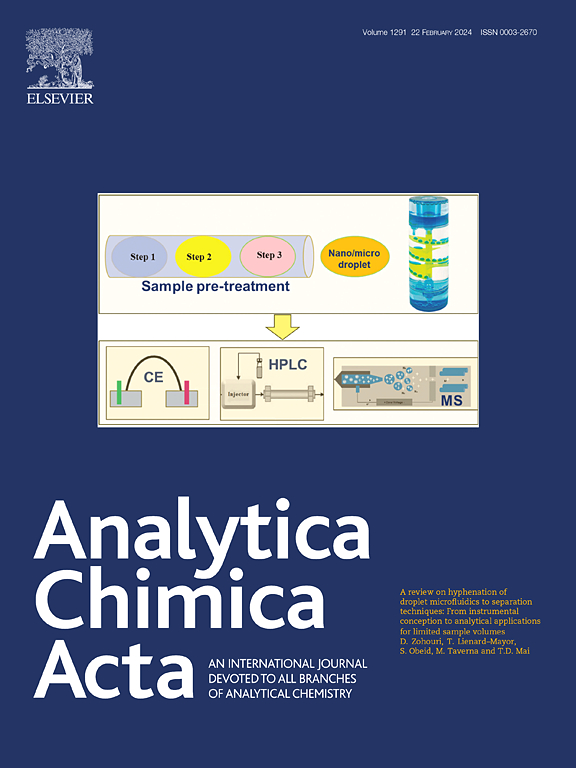使用相应的氨基酰基trna合成酶选择性测量缬氨酸、亮氨酸和异亮氨酸,并应用于纸基分析装置进行比色检测
IF 6
2区 化学
Q1 CHEMISTRY, ANALYTICAL
引用次数: 0
摘要
支链氨基酸(BCAAs)对于维持肌肉性能至关重要,其测量对于评估营养状况、健康和疾病状况至关重要。然而,由于传统酶的选择性有限,对单个支链氨基酸的选择性分析仍然具有挑战性。在本研究中,我们利用相应的氨基酰基- trna合成酶(aaRSs)作为识别元件,探索了20种氨基酸中BCAAs(缬氨酸(Val)、亮氨酸(Leu)和异亮氨酸(Ile))的酶检测方法。基于我们的研究结果,我们开发了一种基于滤纸的Val、Leu和Ile分析装置(PAD)。结果利用酶标仪对各抗原的标度曲线和选择性进行了评价。在aaRS反应之后,用特林德试剂作比色反应。此外,还对真实食品样品进行Val、Leu和Ile分析,以评价其实用性。Val (2 ~ 75 μM)呈线性关系;相关系数:R2 = 0.959), Leu (2 ~ 50 μM;R2 = 0.984), Ile (1 ~ 100 μM;R2 = 0.982),检测限分别为18.5、7.6、8.4 μM。此外,PAD与Val (7 ~ 80 μM)呈线性关系;R2 = 0.978), Leu (9 ~ 80 μM;R2 = 0.956), il (19 ~ 80 μM;R2 = 0.961),检出限分别为2.2、3.1、6.3 μM。重要意义trinder试剂是一种比色试剂,由于其ph为中性,确保了易用性和安全性。此外,它还促进了PAD的开发和Val, Leu和Ile的分析。这项研究的发现有助于推进强大的生物医学设备,精确地用于氨基酸分析。利用USB相机和新颖的RGB值分析方程实现了高分辨率检测。本文章由计算机程序翻译,如有差异,请以英文原文为准。


Selective measurement of valine, leucine, and isoleucine using corresponding aminoacyl-tRNA synthetases and application to paper-based analytical devices for colorimetric detection
Background
Branched-chain amino acids (BCAAs) are vital for maintaining muscle performance and their measurement is critical for assessing nutritional status, health, and disease conditions. However, selective analysis of individual BCAAs remains challenging due to the limited selectivity of conventional enzymes. In this study, we explore the enzymatic detection of BCAAs (valine (Val), leucine (Leu), and isoleucine (Ile)) among 20 amino acids using their corresponding aminoacyl-tRNA synthetases (aaRSs) as recognition elements. Based on our findings, a paper-based analytical device (PAD) for Val, Leu, and Ile was developed using filtration paper.
Results
The calibration curves, and selectivity of each aaRS were assessed using a microplate reader. Trinder's reagent was used as the colorimetric reaction following aaRS reaction. Additionally, Val, Leu, and Ile analysis was conducted on real food samples to evaluate practical applicability. Linear relationships were established for Val (2–75 μM; correlation coefficient: R2 = 0.959), Leu (2–50 μM; R2 = 0.984), and Ile (1–100 μM; R2 = 0.982), with detection limits of 18.5, 7.6, and 8.4 μM, respectively, using the microplate reader. Furthermore, PAD exhibited linear relationships for Val (7–80 μM; R2 = 0.978), Leu (9–80 μM; R2 = 0.956), and Ile (19–80 μM; R2 = 0.961), with detection limits of 2.2, 3.1, and 6.3 μM, respectively. The analysis was completed within 15 min.
Significance
Trinder's reagent, a colorimetric reaction reagent, ensures ease of use and safety owing to its neutral pH. Furthermore, it facilitated the development of PAD and analysis of Val, Leu, and Ile. The findings of this study contribute to the advancement of robust biomedical devices precisely for amino acid analysis. High-resolution detection was accomplished using a USB camera and novel RGB value analysis equations.
求助全文
通过发布文献求助,成功后即可免费获取论文全文。
去求助
来源期刊

Analytica Chimica Acta
化学-分析化学
CiteScore
10.40
自引率
6.50%
发文量
1081
审稿时长
38 days
期刊介绍:
Analytica Chimica Acta has an open access mirror journal Analytica Chimica Acta: X, sharing the same aims and scope, editorial team, submission system and rigorous peer review.
Analytica Chimica Acta provides a forum for the rapid publication of original research, and critical, comprehensive reviews dealing with all aspects of fundamental and applied modern analytical chemistry. The journal welcomes the submission of research papers which report studies concerning the development of new and significant analytical methodologies. In determining the suitability of submitted articles for publication, particular scrutiny will be placed on the degree of novelty and impact of the research and the extent to which it adds to the existing body of knowledge in analytical chemistry.
 求助内容:
求助内容: 应助结果提醒方式:
应助结果提醒方式:


